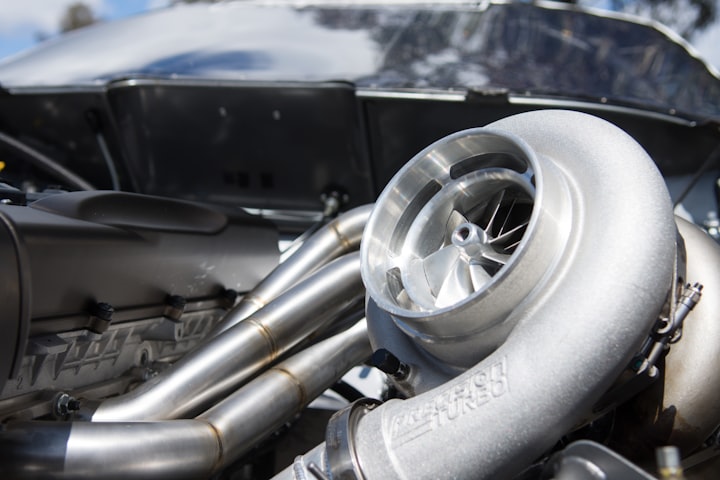what is the first turbocharged car ?
Read the article to know the answer !

The first turbocharged car was the 1962 Chevrolet Corvair Monza GT. However, the first production car to feature a turbocharger was the 1962 Oldsmobile Jetfire. The Jetfire was a special version of the Oldsmobile Cutlass that was equipped with a turbocharged 3.5-liter V8 engine. The turbocharger boosted the engine's output to 215 horsepower, which was a significant increase over the standard engine's 185 horsepower. The Jetfire was only produced for one year, but it paved the way for the widespread use of turbochargers in the automotive industry.
Sure, I'd be happy to provide more information about the first turbocharged car.
The Chevrolet Corvair Monza GT was a concept car that was unveiled at the 1962 New York Auto Show. The car was powered by a turbocharged 2.4-liter flat-six engine that produced 150 horsepower. The turbocharger was designed and built by Garrett AiResearch, a company that specialized in aerospace technology.
While the Corvair Monza GT was the first car to feature a turbocharged engine, it was never produced for the general public. Instead, the Oldsmobile Jetfire was the first production car to offer a turbocharger as an option.
The Jetfire was marketed as a high-performance car that also had good fuel economy, thanks to the turbocharger. However, the turbocharged engine was not very reliable, and many owners experienced problems with the turbocharger and the engine itself. As a result, the Jetfire was only produced for one year, and only a few thousand units were sold.
Despite the early reliability issues, turbochargers eventually became a popular way to increase the power and efficiency of engines. Today, nearly every major automaker offers at least one turbocharged engine option in their lineup, and turbocharging has become a common feature in the automotive industry.
Sure, here are a few more interesting facts about turbocharged engines:
- Turbochargers work by using exhaust gases to spin a turbine, which then compresses the incoming air before it enters the engine. This allows more air to be forced into the engine, which increases its output.
- Turbochargers were first developed in the early 1900s for use in aircraft engines. The first turbocharged aircraft engine was developed by Swiss engineer Alfred Büchi in 1905.
- In the 1980s and 1990s, turbocharging became popular in motorsports, particularly in rallying and Formula 1. Turbocharged engines were able to produce more power than naturally aspirated engines, which gave them an advantage on the track.
- One downside of turbocharging is called "turbo lag." This is the delay between when the driver presses the throttle and when the turbocharger begins to spin and produce boost. Modern turbocharged engines have minimized turbo lag through the use of advanced technology, such as twin-scroll turbochargers and variable geometry turbos.
- Another downside of turbocharging is that it can put additional stress on the engine, which can lead to higher maintenance costs and shorter engine lifespans. However, modern turbocharged engines are designed to be more reliable and durable than their predecessors.
Overall, turbocharging is a technology that has revolutionized the automotive industry and allowed for more powerful and efficient engines. While it has its downsides, the benefits of turbocharging have made it a popular feature in modern cars
- One of the main benefits of turbocharging is that it allows smaller engines to produce more power. This is because the turbocharger can force more air into the engine than it would naturally ingest, which increases its output.
- Turbocharging can also improve fuel efficiency, as it allows the engine to burn fuel more efficiently. By compressing the incoming air, the engine can extract more energy from each fuel molecule, which reduces the amount of fuel it needs to burn to produce a given amount of power.
- In addition to cars, turbocharging is also used in other applications, such as marine engines, locomotives, and power plants. Turbocharging can improve the efficiency and performance of these engines, which can lead to significant cost savings and environmental benefits.
- While turbocharging has become more common in recent years, not all engines are suitable for turbocharging. Engines with high compression ratios, for example, may not be able to handle the increased pressure and temperature that come with turbocharging.
- Another downside of turbocharging is that it can increase the complexity and cost of an engine. Turbocharged engines require additional components, such as intercoolers and wastegates, which can add to the cost and complexity of the engine.
Overall, turbocharging is a technology that has helped to make cars more powerful, efficient, and environmentally friendly. While it has its downsides, the benefits of turbocharging have made it a popular feature in modern vehicles.
About the Creator
Car Community
high quality car stories , everything you should know about every car ever made.






Comments
There are no comments for this story
Be the first to respond and start the conversation.